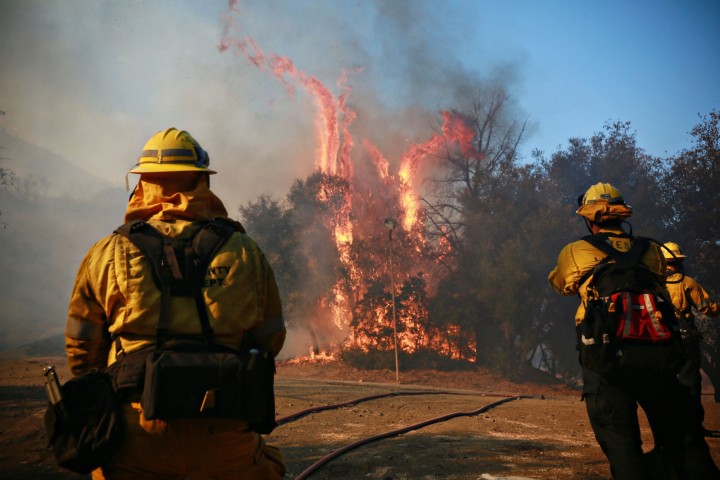California wildfires: Climate change driving ‘horror and the terror’ of devastating blazes, say scientists

“I said it was the new normal a few years ago,’’ says Jerry Brown. “This is serious, but this is only the beginning. This is only a taste of the horror and the terror that will occur in decades.”
As firefighters in California continue to confront a three-week spate of blazes that has reached across the state, attention has also turned to why this year’s wildfires have been so severe. The reason, according to scientists, is climate change.
“It’s warmer weather, more evaporation, and drier conditions. They just burn more,” says Park Williams, a bioclimatologist at Columbia University.
“And we expect this trend to continue. We can’t say if it will happen every year – there are natural variations as well. But we know that when things are drier, a larger area burns.”
Speaking from New York, Williams adds: “We’ve always had the fires. But things are now two or three degrees hotter. That’s enough to make a major difference.”
As Donald Trump continues to refuse to acknowledge the existence of man-made climate change, and as Jay Inslee, the only Democrat running for president on a ticket to address climate change, dropped out of the race this autumn, residents of California and other western states are trying to figure out how to confront the challenge, not just this year but in the years and decades ahead.
The editorial writers at the Los Angeles Times have echoed the words of the former governor, who spoke to Politico, by declaring: “Climate change has set California on fire. Are you paying attention?”
“Nobody can honestly say this is a surprise, given the devastating fires of recent years. Yet it feels surprising all the same. How did things get so bad in California, so quickly,” they write. “The answer is climate change. It is here and our communities are not ready for it.”
The specific causes of the blazes that have been set off across California, focusing specifically in two areas, one near San Bernardino that became known as the Hillside fire, and the Kincade fire in the north, may have been different this year to other blazes.
The energy company Pacific Gas and Electric has been at the centre of controversy by its decision to shut off power to thousands of residents in the hope that broken lines would not trigger more blazes.
The 90-year-old firm, which earlier this year filed for bankruptcy to address liabilities resulting from a string of devastating fires that tore through the north of the state in 2017 and 2018, was found to have been responsible for last November’s Camp fire in the town of Paradise.
The fire killed 85 people and burned more than 150,000 acres, and in doing so becoming the deadliest wildfire incident in the state’s history.
Yet experts say, apart from the specific triggers for the fires – this week, a crash involving a police vehicle chase sparked one fire in Jurupa Valley, southwest of San Bernardino – the broader context is of drier, hotter conditions.
“Since the early 1970s, California’s annual wildfire extent increased fivefold, punctuated by extremely large and destructive wildfires in 2017 and 2018,” Williams and his colleagues write in a paper published this summer in Earth’s Future. “This trend was mainly due to an eightfold increase in the summertime forest fire area and was very likely driven by drying of fuels promoted by human‐induced warming.”
Michael Mann, a climate expert and professor of Earth sciences at Penn State University, says in the American west climate change has increased the risk of fire weather fivefold and doubled how much land has burned. Wildfire frequency, he says, has quadrupled since the 1980s.
“There is little question that years of accumulated fuel from a decade-long drought combined with higher temperatures and an increasingly long dry-season, combined with more persistent weather systems associated with a stalled jet stream, has created the conditions that allow for this more intense, faster-spreading wildfires,” he says.
Asked how such fires could be countered, he replies: “As long as we continue to emit carbon into the atmosphere, and create warmer, drier conditions in California, there is little question that we’ll see a worsening of wildfires.
“The only true solution is to stop burning fossil fuels, generating greenhouse gases, and warming the planet.”
Last year, the world’s leading climate scientists said the world had barely a dozen years to act to make massive changes to global energy infrastructure to limit global warming to moderate levels. “There is no documented historic precedent,” said the United Nations’ Intergovernmental Panel on Climate Change.
California has long been aware of the impact of powerful hot and dry breezes known as the Santa Ana, or Diablo, winds. Scientists say these winds may also be shifting their pattern.
Janin Guzman-Morales, a postdoctoral researcher at the Scripps Institution of Oceanography at the University of California, has told The New York Times that the winds may become less frequent. She says her research suggests the state could see a later wildfire season.
“The window for wildfires is expanding towards winter,” she says.
On Friday, firefighters report some good news. Calmer weather allowed crews to increase containment of the wildfires and winds subsided in virtually all parts of the state, though so-called red flag warnings for fire danger because of winds and ultra-dry conditions remained in place.
Around 200,000 residents of Sonoma County, northwest of San Francisco, have been allowed to return home, even as the fire that forced them to evacuate continues.
“I think when we left, and especially Sunday, we didn’t think we’d be coming back,” Brenda Catelani, a resident of the town of Windsor, tells the Associated Press, as she examines chunks of burned embers and leaves scattered outside her home. “We feel extremely lucky.

